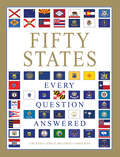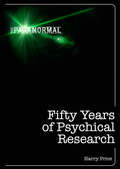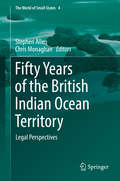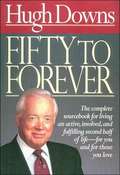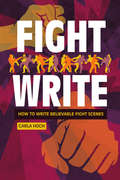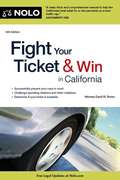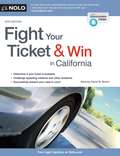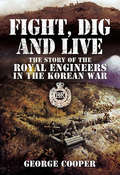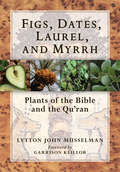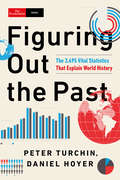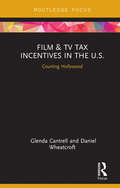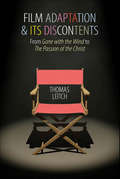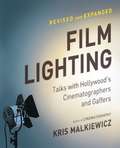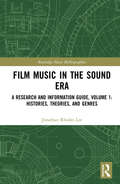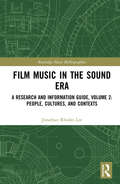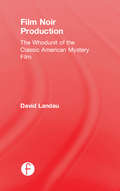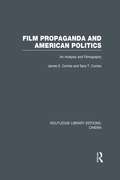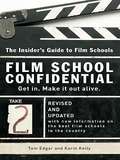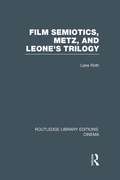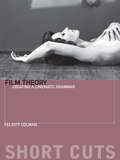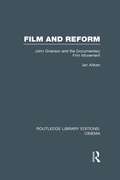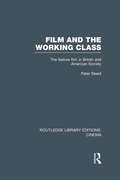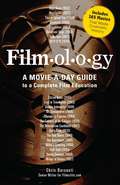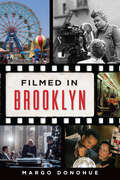- Table View
- List View
Fifty States: Every Question Answered
by Marcel Brousseau Amber Rose Lori BairdTake a tour of America with this outstanding reference—including photos, maps, and extensive facts about each state&’s geography, history—and more. What was the last state to join the Union? What does the state quarter for Alabama look like? What is the state bird of Texas? How did Vermont get its name? All the answers are contained in Fifty States: Every Question Answered! Whether you&’re a student or just a history buff, this book is a great reference manual to each state&’s geography, history, factual details, and ecology. Beautiful color photos and maps also provide a view of how the landscape has changed over the years. Young and old alike will enjoy this adventurous, wide-ranging walk through the United States of America.
Fifty Years of Psychical Research: A Critical Survey (The Paranormal)
by Harry Price1939. A critical survey. Contents: phenomena investigated; beginnings of organized research, the story of the S. P. R. ; a fit subject of university study and research; fifty years of psychical phenomena; the Schneider Boys; Margery; Stella C. ; Rosalie; miracles of the mind, some famous mental mediums; story of E. S. P. ; mechanics of spiritualism; law and the medium; scientific method of psychical research; science solves the fire walk mystery; broadcasting the occult; books that have made history; I believe.
Fifty Years of the British Indian Ocean Territory: Legal Perspectives (The World of Small States #4)
by Stephen Allen Chris MonaghanThis book offers a detailed account of the legal issues concerning the British Indian Ocean Territory (Chagos Islands) by leading experts in the field. It examines the broader significance of the ongoing Bancoult litigation in the UK Courts, the Chagos Islanders' petition to the European Court of Human Rights and Mauritius' successful challenge, under the UN Convention of the Law of the Sea, to the UK government's creation of a Marine Protected Area around the Chagos Archipelago. This book, produced in response to the 50th anniversary of the BIOT's founding, also assesses the impact of the decisions taken in respect of the Territory against a wider background of decolonization while addressing important questions about the lawfulness of maintaining Overseas Territories in the post-colonial era.The chapter ‘Anachronistic As Colonial Remnants May Be...’ - Locating the Rights of the Chagos Islanders As A Case Study of the Operation of Human Rights Law in Colonial Territories is open access under a CC BY 4.0 license via link.springer.com.
Fifty to Forever
by Hugh DownsHugh Downs, a man who has thoroughly researched issues affecting older adults, has good news for everyone entering the 50-plus generation. The news, as Downs relates in this uplifting, fact-filled volume, is that older adults now have more choices than ever before when they consider how they want to live, work, and play in the years to come. What's the catch? Just one: understanding that with the multitude of choices come the responsibilities of research and decision making. But rest easy--with this book, Hugh Downs has done most of the homework for us. What's left is the decision making. From health care to the selection of living arrangements, Fifty to Forever gives older adults the background they need to make their choices with confidence.
Fight Write: How to Write Believable Fight Scenes
by Carla HochWhether a side-street skirmish or an all-out war, fight scenes bring action to the pages of every kind of fiction. But a poorly done or unbelievable fight scene can ruin a great book in an instant. In Fight Write you'll learn practical tips, terminology, and the science behind crafting realistic fight scenes for your fiction. Broken up into "Rounds," trained fighter and writer Carla Hoch guides you through the many factors you'll need to consider when developing battles and brawls.In Round 1, you will consider how the Who, When, Where, and Why questions affect what type of fight scene you want to craft.Round 2 delves into the human factors of biology (think fight or flight and adrenaline) and psychology (aggression and response to injuring or killing another person).Round 3 explores different fighting styles that are appropriate for different situations: How would a character fight from a prone position versus being attacked in the street? What is the vocabulary used to describe these styles?Round 4 considers weaponry and will guide you to select the best weapon for your characters, including nontraditional weapons of opportunity, while also thinking about the nitty-gritty details of using them.In Round 5, you'll learn how to accurately describe realistic injuries sustained from the fights and certain weapons, and what kind of injuries will kill a character or render them unable to fight further.By taking into account where your character is in the world, when in history the fight is happening, what the character's motivation for fighting is, and much more, you'll be able write fight scenes unique to your plot and characters, all while satisfying your reader's discerning eye.
Fight Your Ticket & Win in California
by David BrownWin your traffic court case with the book that's helped thousands of Californians! A traffic conviction can add hundreds of dollars to your yearly auto insurance premiums. Fight Your Ticket & Win in California shows you how to handle your case in traffic court, get the right kind of hearing and win. Attorney David Brown provides you with the detailed tactics you need to: prepare and present your evidence argue before a judge cross-examine a police officer's testimony get your case dismissed appeal a decision determine the consequences of your violation The 14th edition provides the latest legal information for California drivers, including fines and penalties, and contains fully up-to-date information on recently signed legislation regarding cell phone use.
Fight Your Ticket & Win in California
by David W. BrownA traffic conviction can add hundreds of dollars to your yearly auto insurance premiums. Fight Your Ticket & Win in California shows you how to handle your case in traffic court, get the right kind of hearing and win. Attorney David Brown provides you with the detailed tactics you need to: . prepare and present your evidence . argue before a judge . cross examine a police officer's testimony . get your case dismissed . appeal a decision . determine the consequences of your violation This edition provides the latest legal information for California drivers, including fines and penalties, and contains fully up to date information on recently signed legislation regarding cell phone use. Check out Nolo's list of California products. Not a California resident? Check out Beat Your Ticket.
Fight, Dig and Live: The Story of the Royal Engineers in the Korean War
by George CooperThe Korean War, which began with an unprovoked attack by North Korea in 1950, went on for three long years. Over 100,000 soldiers of the United Nations forces, including those of the Republic of Korea, were killed and three times that number wounded. United Kingdom casualties amounted to some 300 Officers and 4,000 Other Ranks. The Royal Engineers deployed a Field Squadron to Korea in the Autumn of 1950 and this was expanded to a Regiment the following year. Involved in fierce fighting, the Sappers suffered grievous casualties including 42 killed and several hundred wounded. Their gallantry was rewarded by numerous gallantry awards, including two DSOs, thirteen MCs, (one by the author), eight MMs and the most distinguished of all, a Distinguished Conduct Medal, second only to the Victoria Cross.It was a vicious war whose intensity never slackened and in the last two months alone the Communist artillery fired over 700,000 rounds against 4.7 million fired back by the United Nations. The Royal Engineers were involved at all levels, from patrols and minefields, to defense works and, providing support to all manner of operations such as transportation, bridging and the important provision of postal services, so vital for morale. Inevitably, though, the focus in that of a war like Korea is often on sapper participation in the forward area where they were often involved in close-quarter fighting with the enemy. Sappers certainly lived up to the title of this book: Fight, Dig and Live.
Figs, Dates, Laurel, and Myrrh: Plants of the Bible and the Quran
by Garrison Keillor Lytton John MusselmanThis book celebrates the plants of the Old Testament and New Testament, including the Apocrypha, and of the Quran. From acacia, the wood of the tabernacle, to wormwood, whose bitter leaves cured intestinal worms, 81 fascinating chapters—covering every plant that has a true botanical counterpart—tell the stories of the fruits and grains, grasses and trees, flowers and fragrances of ancient lore. The descriptions include the plants' botanical characteristics, habitat, uses, and literary context. With evocative quotations and revelatory interpretations, this information is all the more critical today as the traditional agrarian societies that knew the plants intimately become urbanized.The unusually broad geographic range of this volume extends beyond Israel to encompass the Holy Land's biblical neighbors from southern Turkey to central Sudan and from Cyprus to the Iraq border.Richly illustrated with extensive color photography and with a foreword by the incomparable Garrison Keillor, this delightful ecumenical botany offers the welcome tonic of a deep look into an enduring, shared natural heritage.
Figuring Out the Past: The 3,495 Vital Statistics that Explain World History
by Peter Turchin Daniel HoyerWhat was history's biggest empire? Or the tallest building of the ancient world? What was the plumbing like in medieval Byzantium? The average wage in the Mughal Empire? Where did scientific writing first emerge? What was the bloodiest ever ritual human sacrifice?We are used to thinking about history in terms of stories. Yet we understand our own world through data: cast arrays of statistics that reveal the workings of our societies. In Figuring Out the Past, radical historians Peter Turchin and Dan Hoyer dive into the numbers that reveal the true shape of the past, drawing on their own Seshat project, a staggeringly ambitious attempt to log every data point that can be gathered for every society that has ever existed. This book does more than tell the story of humanity: it shows you the big picture, by the numbers.
Film & TV Tax Incentives in the U.S.: Courting Hollywood (Routledge Studies in Media Theory and Practice)
by Glenda Cantrell Daniel WheatcroftEntertainment tax incentives are one of the greatest tools in the arsenal of filmmaking. They pay a portion of production expenditures back to the filmmaker, while creating powerful economic engines for the states who implement them properly. They are high in the list of considerations for executives to sign off before a movie receives the go-ahead for production, even to the point of dictating the location of where a production is filmed. Yet, they are misunderstood by the filmmakers who use them, the politicians who create them, the economists who measure them, and even the scholars who study them. This book puts all the pieces together in a comprehensive look at how the entertainment industry works, how it uses incentives, and how incentives can benefit a filmmaker – or a state.
Film Adaptation and Its Discontents: From Gone with the Wind to The Passion of the Christ
by Thomas LeitchMost books on film adaptation—the relation between films and their literary sources—focus on a series of close one-to-one comparisons between specific films and canonical novels. This volume identifies and investigates a far wider array of problems posed by the process of adaptation. Beginning with an examination of why adaptation study has so often supported the institution of literature rather than fostering the practice of literacy, Thomas Leitch considers how the creators of short silent films attempted to give them the weight of literature, what sorts of fidelity are possible in an adaptation of sacred scripture, what it means for an adaptation to pose as an introduction to, rather than a transcription of, a literary classic, and why and how some films have sought impossibly close fidelity to their sources. After examining the surprisingly divergent fidelity claims made by three different kinds of canonical adaptations, Leitch's analysis moves beyond literary sources to consider why a small number of adapters have risen to the status of auteurs and how illustrated books, comic strips, video games, and true stories have been adapted to the screen. The range of films studied, from silent Shakespeare to Sherlock Holmes to The Lord of the Rings, is as broad as the problems that come under review.
Film Lighting: Talks with Hollywood's Cinematographers and Gaffer
by Kris MalkiewiczNewly revised and updated, Film Lighting is an indispensible sourcebook for the aspiring and practicing cinematographer, based on extensive interviews with leading cinematographers and gaffers in the film industry.Film lighting is a living, dynamic art influenced by new technologies and the changing styles of leading cinematographers. A combination of state-of-the-art technology and in-depth interviews with industry experts, Film Lighting provides an inside look at how cinematographers and film directors establish the visual concept of the film and use the lighting to create a certain atmosphere.Kris Malkiewicz uses firsthand material from the experts he interviewed while researching this book. Among these are leading cinematographers Dion Beebe, Russell Carpenter, Caleb Deschanel, Robert Elswit, Mauro Fiore, Adam Holender, Janusz Kaminski, Matthew Libatique, Rodrigo Prieto, Harris Savides, Dante Spinotti, and Vilmos Zsigmond. This updated version of Film Lighting fills a growing need in the industry and will be a perennial, invaluable resource.
Film Music in the Sound Era: A Research and Information Guide, Volume 1: Histories, Theories, and Genres (Routledge Music Bibliographies)
by Jonathan Rhodes LeeFilm Music in the Sound Era: A Research and Information Guide offers a comprehensive bibliography of scholarship on music in sound film (1927–2017). Thematically organized sections cover historical studies, studies of musicians and filmmakers, genre studies, theory and aesthetics, and other key aspects of film music studies. Broad coverage of works from around the globe, paired with robust indexes and thorough cross-referencing, make this research guide an invaluable tool for all scholars and students investigating the intersection of music and film. This guide is published in two volumes: Volume 1: Histories, Theories, and Genres covers overviews, historical surveys, theory and criticism, studies of film genres, and case studies of individual films. Volume 2: People, Cultures, and Contexts covers individual people, social and cultural studies, studies of musical genre, pedagogy, and the Industry. A complete index is included in each volume.
Film Music in the Sound Era: A Research and Information Guide, Volume 2: People, Cultures, and Contexts (Routledge Music Bibliographies)
by Jonathan Rhodes LeeFilm Music in the Sound Era: A Research and Information Guide offers a comprehensive bibliography of scholarship on music in sound film (1927–2017). Thematically organized sections cover historical studies, studies of musicians and filmmakers, genre studies, theory and aesthetics, and other key aspects of film music studies. Broad coverage of works from around the globe, paired with robust indexes and thorough cross-referencing, make this research guide an invaluable tool for all scholars and students investigating the intersection of music and film. This guide is published in two volumes: Volume 1: Histories, Theories, and Genres covers overviews, historical surveys, theory and criticism, studies of film genres, and case studies of individual films. Volume 2: People, Cultures, and Contexts covers individual people, social and cultural studies, studies of musical genre, pedagogy, and the Industry. A complete index is included in each volume.
Film Noir Production: The Whodunit of the Classic American Mystery Film
by David LandauDavid Landau’s Film Noir Production: The Whodunit of the Classic American Mystery Film is a book meant for those who like a good story, one the Noir Films always delivered, concentrating on the characters more than anything else. Readers will find in these pages many behind-the-scenes tales of the productions of certain hard-boiled film classics and the prime players involved in their creation, from Darryl Zanuck and Raymond Chandler to John Seitz and Billy Wilder. This book features: A clear understanding of how movies are actually made and all the creative artists that contribute, creating a better appreciation for the many talented artistic collaborators that worked in the Hollywood Studio System and who together created film noir. A behind-the-scenes look at the making of a classic film noir movie that typifies the chapter’s subject, allowing the reader to view that film in a new light and think about it from a new prospective. Appendices of suggested films to screen, film noir books for further reading, and downloadable files containing discussion points and class assignments for each chapter. An informative and conversational writing style, making the subject matter easy to digest and fun to read. This book is an indispensible companion text for anyone studying or interested in film noir, film history, the bygone days of the Hollywood film factories or how movies are actually made.
Film Propaganda and American Politics: An Analysis and Filmography (Routledge Library Editions: Cinema #Vol. 4)
by James Combs Sara T. CombsOriginally published in 1994, this important book traces the rise of film propaganda in the 20th Century, discussing specifically how film can be used to manipulate public perception and opinions. Two distinct areas are covered: war propaganda, including feature and documentary films regarding warfare; and civilian propaganda, including films that address a variety of political subjects. Although the focus is American film and American politics, this book offers insights for all those interested in the affect of film on the minds of citizens of any country or state.
Film School Confidential
by Tom EdgarEvaluates twenty-six film school programs in the United States, offers tips on the application and admission process, and includes comments from students and faculty.
Film Semiotics, Metz, and Leone's Trilogy (Routledge Library Editions: Cinema)
by Lane RothSemiotics offers a systematic approach to analysing the stylistic structure of film. When this study was originally published in 1983 this was a recent addition to the methods of film study and it presents an explanation of film semiotics with direct application to comparative film research. It takes as its representative subject one trilogy of films and applies semiology, with careful textual analysis. The book begins with a basic introduction to semiotics and the ideas of Christian Metz on cinesemiotics. It then presents a syntagmatic analysis of each of the three Dollars films, with an outline of autonomous segments for each and a discussion of the findings before undertaking a wider analysis of the trilogy as a whole with commentary on the stylistic unity of the director’s work. This book, an enduring detailed study of these three films, also outlines clearly this method of classifying the formal structuring codes of film communication.
Film Theory
by Felicity ColmanFilm Theory addresses the core concepts and arguments created or used by academics, critical film theorists, and filmmakers, including the work of Dudley Andrew, Raymond Bellour, Mary Ann Doane, Miriam Hansen, bell hooks, Siegfried Kracauer, Raul Ruiz, P. Adams Sitney, Bernard Stiegler, and Pier Paolo Pasolini. This volume takes the position that film theory is a form of writing that produces a unique cinematic grammar; and like all grammars, it forms part of the system of rules that govern a language, and is thus applicable to wider range of media forms. In their creation of authorial trends, identification of the technology of cinema as a creative force, and production of films as aesthetic markers, film theories contribute an epistemological resource that connects the technologies of filmmaking and film composition. This book explores these connections through film theorisations of processes of the diagrammatisation (the systems, methodologies, concepts, histories) of cinematic matters of the filmic world.
Film Theory
by Felicity ColmanFilm Theory addresses the core concepts and arguments created or used by academics, critical film theorists, and filmmakers, including the work of Dudley Andrew, Raymond Bellour, Mary Ann Doane, Miriam Hansen, bell hooks, Siegfried Kracauer, Raul Ruiz, P. Adams Sitney, Bernard Stiegler, and Pier Paolo Pasolini. This volume takes the position that film theory is a form of writing that produces a unique cinematic grammar; and like all grammars, it forms part of the system of rules that govern a language, and is thus applicable to wider range of media forms. In their creation of authorial trends, identification of the technology of cinema as a creative force, and production of films as aesthetic markers, film theories contribute an epistemological resource that connects the technologies of filmmaking and film composition. This book explores these connections through film theorisations of processes of the diagrammatisation (the systems, methodologies, concepts, histories) of cinematic matters of the filmic world.
Film and Reform: John Grierson and the Documentary Film Movement (Routledge Library Editions: Cinema)
by Ian AitkenBest known for his documentaries such as Drifters, North Sea, and Housing Problems, John Grierson was the most important figure in the British documentary film movement and one of the most influential of British film theorists. This major assessment of Grierson and the documentary film movement examines the intellectual and aesthetic influences on his work, focusing on the material he produced in the inter-war years and comparing the idealistic strain of Grierson’s social commentary with other social reformists such as the Next Five Years Group and writers like Orwell and Priestley. Underlining the link between film and reform, the book clarifies the meaning and significance of Grierson’s ideas and the historical role of the documentary film movement. Originally published in 1990.
Film and the Working Class: The Feature Film in British and American Society (Routledge Library Editions: Cinema)
by Peter SteadTaking the subject chronologically from the 1890s to when the book was initially published in 1989, this book analyses those films specifically concerned with working-class conditions and struggle, and discusses them within the context of the debate on the social significance of the feature film. It concentrates on films which depict labour organizations and political activists, as well as life in working-class communities and actors with working-class identities such as James Cagney. Reviews of the original edition: ‘…fills a gap in film studies…the study of social and labour history, and the development of popular culture in Britain and the United States.’
Film*ol*o*gy
by Chris BarsantiSure, you love the movies. But how much do you really know about the ones that really made a difference? Whether it's Birth of a Nation, the brilliant silent film that fanned the flames of racism; Easy Rider, the clarion call for a generation; or Inglourious Basterds, Tarantino's bloody take on art as propaganda, Filmology gives you the most entertaining crash course in good film ever produced-one movie a day. This is not just another greatest-movies celebration. Pairing cinema's lesser-seen gems alongside blockbusters, great early works from the pioneers of film alongside often-overlooked films from great directors, noted film critic Chris Barsanti unveils the movies that you must see-for your viewing pleasure. Filmology: So you can watch your way to an education in film!
Filmed in Brooklyn
by Margo Donohue"Shooting in Brooklyn is like opening a time capsule. Nothing has changed. Everything looks like it did in the eighties." -Freddie Prinze, Jr. Discover the iconic films, legendary personalities and the locations for timeless big screen moments that took place in Brooklyn. From Saturday Night Fever to numerous Spike Lee Joints, readers can learn about Brooklyn's cinematic past or discover locations to visit today.
